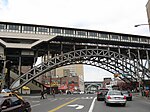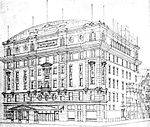Freddy's Fashion Mart attack
1990s crimes in New York City1990s in Manhattan1995 in New York City1995 mass shootings in the United States1995 murders in the United States ... and 19 more
20th-century mass murder in the United StatesAntisemitic attacks and incidents in the United StatesAntisemitism in New York (state)Arson in New York CityAttacks in the United States in 1995Crimes in ManhattanFires in New York CityHarlemHate crimesHistory of racism in New York (state)Hostage taking in the United StatesMass murder in 1995Mass murder in New York (state)Mass murder in New York CityMass murder in the United StatesMass shootings in the United StatesMassacres in the United StatesMurder–suicides in New York CityRacially motivated violence in the United States
On December 8, 1995, eight people, including the assailant, were killed when a gunman seized hostages at Freddy's Fashion Mart in Harlem, New York City and set the building on fire.
Excerpt from the Wikipedia article Freddy's Fashion Mart attack (License: CC BY-SA 3.0, Authors).Freddy's Fashion Mart attack
West 125th Street, New York Manhattan
Geographical coordinates (GPS) Address Nearby Places Show on map
Geographical coordinates (GPS)
| Latitude | Longitude |
|---|---|
| N 40.80969 ° | E -73.9508 ° |
Address
West 125th Street 268
10027 New York, Manhattan
New York, United States
Open on Google Maps








